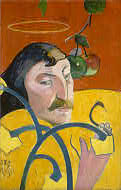
|
Paul Gauguin (artist) French, 1848 - 1903 Self-Portrait, 1889 oil on wood overall: 79.2 x 51.3 cm (31 3/16 x 20 3/16 in.) Chester Dale Collection 1963.10.150 |
Self-portraiture constituted a significant element of Gauguin's production, particularly in 1888 and 1889. Gauguin's interest was prompted in part by Van Gogh's 1888 portrait series including La Mousmé, which he knew from Van Gogh's letters. In addition, Van Gogh hoped to establish an artists' colony in the south that could be analogous to Gauguin's circle in Brittany, and proposed an exchange of self-portraits. Gauguin's only known statements about his self-portraiture concern one he painted in response to Van Gogh. He described manipulating his image to accord with a predetermined symbolic program, a program somewhat similar to the Gallery Self-Portrait and referring to the 1888 depiction as "the face of an outlaw . . . with an inner nobility and gentleness," a face that is "symbol of the contemporary impressionist painter" and "a portrait of all wretched victims of society."
The Gallery Self-Portrait, painted on a cupboard door in the dining room of an inn in the Breton hamlet Le Pouldu, is one of Gauguin's most important and radical paintings. His haloed head and disembodied right hand, a snake inserted between the fingers, float on amorphous zones of yellow and red. Elements of caricature add an ironic and aggressively ambivalent inflection to this painted assertion of Gauguin's artistic superiority and make him the sardonic hero of his new aesthetic system.


